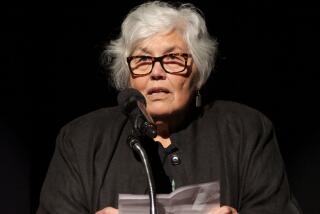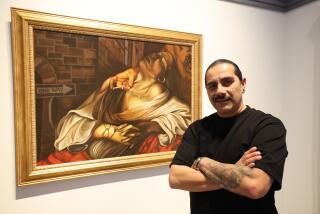Cultural Exchange: Chilean artists confront Pinochet horrors
A final reckoning of the Pinochet dictatorship’s 16-year reign of terror may be many years away, but a flourishing of art, theater, film and literary works dealing with the nightmarish era is a sure sign that Chilean society is coming to grips with what happened and how.
Recent works that explore Chile’s dark chapter include smash television series such as “The Cardinal’s Archives” and “The ‘80s.” The first show dramatized the Catholic Church’s resistance to state terror while the other tracked one family’s experience of the police state over time.
The film “Post Mortem,” directed by Pablo Larrain, focused on overthrown Socialist President Salvador Allende’s death while the narrative of Andrés Wood’s “Machuca” highlighted hopes for empowerment among the poor that Allende raised before he was toppled. The dictatorship and its victims have inspired provocative installation works by Alfredo Jaar and Juan Pablo Langlois as well as the poems of Raul Zurita, one of Latin America’s most celebrated writers.
Guillermo Calderon’s stage drama “Villa,” which is about the Villa Grimaldi, a Santiago mansion where hundreds of detainees were tortured and killed, has received rave notices not just here but internationally. The play is about three women and their differing opinions about what should be done with the site.
“The dictatorship marked the low point of Chileans’ coexistence. We were in the abyss,” said Ricardo Brodsky, director of the Museum of Memory in Santiago. “There is an increasing will to know and discuss what happened and art provides a way of approaching it.”
The museum, with frequent theatrical presentations and art exhibitions, has become a focal point for much of the cultural goings-on. The striking three-story structure designed by Brazilian architect Mario Figueroa is a highly symbolic work of art in and of itself.
Dedicated to the 41,000 victims who were arrested, tortured or killed from 1973 to 1989 in the aftermath of the overthrow of Allende, the museum features a sheath of oxidized copper mesh, the country’s main natural resource, that envelops a three-story glass structure signifying light and transparency. Inaugurated in January 2010 with the backing of then-President Michelle Bachelet, who herself was a torture victim under Gen. Augusto Pinochet’s regime, the museum averages about 12,000 visitors a month.
“The building doesn’t go unnoticed, and that’s on purpose,” Brodsky said. Inside is a massive archive of victims’ testimonies that has been declared “patrimony of humanity” by UNESCO, meaning it is of global importance. “Its function is to recover the biographies of victims so they don’t remain mere shadows.”
Theatrical works like “Villa” are serving as “transmitters of memory” at a time when many Chileans still find it hard to discuss the dictatorship because of shame, a wish to avoid political arguments or a human desire to “turn the page,” said Nancy Nicholls, a historian at the University of Christian Humanism here.
“The problem with turning the page is that it only leaves to the next generation to shine a light on what happened. That’s the case in Germany now where there is a sort of ‘memory boom’ underway,” Nicholls said, describing the willingness of young Germans to confront the Holocaust and the Hitler era in a way their parents and grandparents could not. Art helps to facilitate the process by “conceptualizing” traumatic experiences in a more useful way than direct debate, she said, adding that “art connects people.”
What happened — the extent of human rights violations under Pinochet — is still being disputed in what some here describe as a “war for history” fought out by opposing, highly politicized factions. “The history of crimes go from day one to the end in 1989, with various degrees of intensity. Murder was in the dictatorship’s DNA,” Brodsky said.
Earlier this year, the third “truth commission” formed since the 1990 return to democracy to investigate Pinochet added 10,000 more victims to the ledger. Of 41,000 detained, tortured and disappeared, at least 3,200 are thought to have died.
In the material sense, the Chilean government has done right by giving financial compensation to 300,000 victims and their families, Brodsky said. But hundreds of cases remain unresolved, partly because of the 1978 amnesty given to the armed forces members who participated in human rights abuses. Moreover, evidentiary rules covering criminal proceedings stemming from the dictatorship favors defendants, he said.
Chile is only one of several Latin American countries trying to confront a dictatorial past. Earlier this month, an Argentine court convicted two ex military men of murder during that country’s 1976-83 dictatorship. Still unresolved, however, is how many victims there were, with estimates ranging from 10,000 to 30,000.
Brodsky said the museum is part of a loose-knit “coalition of places of conscience” in countries that have experienced state terror. More are on the way. Several Latin American countries including Colombia, Peru, Guatemala and Dominican Republic have been in touch to request help in setting up similar museums.
Brodsky and Nicholls agreed that the museum and works of art focusing on the Pinochet era share a similar purpose and challenge. “We try to manage the emotions of visitors, especially kids, so that the experience is useful and not simply paralyzing,” Brodsky said. “We have to serve as a bridge between feelings and a commitment to certain values like tolerance and respect for diversity.”
Said Nicholls: “A work of art should help you recognize what happened and ask why. It should make the past more intelligible so that those who experience art somehow emerge with a better defined sense of human rights and a determination not to let abuses happen again.”
Added Brodsky: “Those are the goals. Are we achieving them? Only time will tell.”
More to Read
The biggest entertainment stories
Get our big stories about Hollywood, film, television, music, arts, culture and more right in your inbox as soon as they publish.
You may occasionally receive promotional content from the Los Angeles Times.






